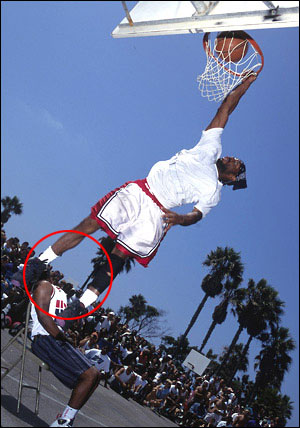I really love this paper (PDF) that discusses the unexpected talents of a whole mob of people when they put themselves to a task.
When Halo2 was going to be released, they leaked a trailer for the game. At the end of the trailer there was a flash of a link to a website, Ilovebees.com. It was supposed to be the website of a beekeeper, but there was something obviously wrong with the site. A plea for help from the supposed webmaster was the beginning of an Alternate Reality Game that drew 600 000 participants (!) into the search to figure out whatever was happening there. The company behind the whole thing strung everybody along with a masterful set of clues and puzzles that were really hard (basically impossible) for any one person to do, but were achievable for a large group if everybody worked together, hence the bees reference to a hive mind.
Here’s a great example of what they pushed these people to do:
As the players pushed themselves to succeed at every challenge, we were forced to present them with a problem that we ourselves weren’t sure they could successfully solve. We called it the “relay missionâ€, and it was designed to make or break their collective intelligence. Shortly after sunrise on a Tuesday late in the game, we directed the voice actress playing Melissa the Operator to start making live calls to phones on the East Coast. She asked whoever answered the phone tell her something personal—for instance, a five-word phrase that described something they are very, very good at. The Operator then informed the player that she would be calling another payphone somewhere in the world, as soon as one hour from that moment. Whoever answered the phone needed to repeat back to her the same five-world phrase. Then she hung up, providing no information about which phone she intended to call.
Our plan was, over the course of the day, to repeat this relay mission up to a dozen times, shortening the time increments until we would posed our final, seemingly impossible challenge: to relay an improvised personal message worldwide with only a fifteen-second time differential between the first call and the second. But we were fairly certain the players would never get that far. We had designed a number of failure responses so that we could reward players for however close they came, fully expecting them to eventually hit a wall past which they could not coordinate and perform.
The players, however, never hit that wall. By using their early axon coordination spreadsheets—they knew which players lived near which phones, and had their mobile contact information—and by consulting the timeline of GPS coordinates for that day, and crossreferencing that data against their knowledge of which payphones the Operator had favored in the past for live calls, they were able to deduce which phones were likely to ring, and who was most likely to answer those phones in the time window the Operator presented. They then set up a relay team of online players broadcasting each secret five-word phrase as it was invented to all players known to be in the field; hundreds of players online called hundreds of players at payphones so that they could update each other virtually instantly.
….
Before we saw what the players were capable of, we never imagined that a massively multi-player team of young Halo fans would be capable of building, in one day, a worldwide, instantaneous, mobile broadcasting platform. The idea to ask them to do just that was only possible after the players’ brilliant coordination efforts emerged.
The best part is how the company kept changing and improvising the next steps in the puzzle to keep the players challenged and interested. I love the potential here for collaboration and working together that this kind of thing shows humans are capable of doing. I wonder what kind of problems, challenges, and obstacles we will overcome together in the future with technology allowing us to work together effectively in groups of thousands, even millions? That kind of thing just hasn’t been possible before now, it’s awesome to imagine.

